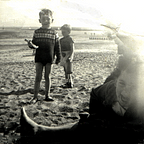Beatles Christmas Records: 1966–69
We thought it was time we had an entirely different approach. Paul McCartney
The story of the first three Beatles Christmas records is here
Pantomime: Everywhere It’s Christmas (1966)
By 1966 the band were in a position to wiggle out of making more Christmas records. To general surprise they went in the other direction, making a concerted effort to reinvent their ‘traditional’ Christmas message.
Pantomime is an audacious technical achievement and an early prototype of Sergeant Pepper. Ten segments are crammed into an experimental seven minute soundscape. Out go the season’s greetings, personalised messages and indeed The Beatles themselves.
As on Pepper, The Beatles morph into fictional characters, leaning heavily on the Pantomime/music hall conventions. The song snatches are distinctive. Orowayna sung by a cod ‘Corsican choir’ is strangely haunting, the bawdy Please Don’t Bring Your Banjo Back (I Don’t Know Where it’s Been) genuinely comical. Even Mal Evans reprise of the title songe is affecting in its simplicity
McCartney is the driving force — he even creates the illustration for the cover- but the others join on the project in with gusto. Another key factor is the production by George Martin — who draws on his background as perhaps the finest producer of British comedy records.
The end result is an artistic triumph that looks back to the zaniness of Help! but also ahead to the experimentation of the coming album.
Christmas Time Is Here Again! (1967)
In the aftermath of Bryan’s death in August, Paul insisted that their obligations were dutifully attended to. The others moaned vociferously but perhaps at a deeper level needed to find an outlet for their grief.
This perhaps explains the remarkable energy they invested in the first post Epstein Christmas message. Ignoring the E shaped elephant in the studio, they focussed on extending on the innovations of the previous year.
George Martin moves centre stage, utilising both his studio expertise and experience of producing comedy records. He even performs a faux Christmas message to young Beatles fans — which they promptly satirise.
That The Beatles could show such invention for what was widely considered a trifle is remarkable. It will be the last Christmas record they will record with all four physically present — and a fitting finale.
The Beatles’ 1968 Christmas Record
The final two Christmas records are essentially compilations of individual contributions from each band member. These were then mixed by Beatles friend and radio wizard, Kenny Everrett, does a remarkable job in creating coherent soundscapes.
Christmas 1968 feels like a mash up of studio outtakes — but there are the now traditional parodic versions of Beatles standards. These include a falsetto version of Nowhere Man in the style of Tiny Tim. George Harrison explicitly acknowledges this with a clever allusion to A Christmas Carol (“Thank you and God bless you, Tiny)
John is surprisingly energised, punning in all direction, while fans of Ringo’s (broad) comedy are not disappointed. Paul provides the tunes: including an intriguingly promising sung version of Merry Christmas.
Like the White Album it goes on a little too long and their are subtle signs of band disunity. Lennon’s poem ‘Jock and Yono’s seems jarringly unseasonal, most pointedly in its reference to ‘some of their beast friends’.
Meanwhile, The Beatles returned to the top of the UK singles chart for a record fourth time — see here
Happy Christmas 1969
By the release of the final Christmas record the band have fallen apart. John’s opening request to the ‘lads’ to wish fans a happy Christmas is desultory and receives a response in kind.
Everyone is moving on. George has essentially bailed — providing six seconds of recording. Ringo openly plugs his new film Magic Christian. Even Paul’s song ‘This Is To Wish You’ has a weary feel and is message is uncharacteristically downbeat. Even for Mr Beatle the jig is up.
Yoko has moved to the centre of proceedings. Her voice comes through after 20 seconds and we are reminded that she is now ‘Mrs Lennon’. The new lord and lady of Tittenhurst Park guide us around their Ascott estate. The laboured comic exchanges between the couple underline the chasm that has opened between the performers and their British audience. In just over a year they will leave the UK forever
Everett does adds some brilliant wistful touches to this swan song, most notably the chords from The End. And in a bittersweet shout out to the first Christmas record, John sings Good King Wenceslas, getting the words right this time.
The story of the first three Beatles Christmas records is here. A remarkable mashup of all the songs is here. More on the Beatles Christmas records in this Rolling Stone survey
